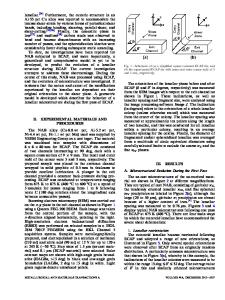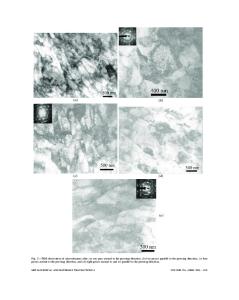Effect of die shape on the deformation behavior in equal-channel angular pressing
- PDF / 1,755,524 Bytes
- 8 Pages / 612 x 792 pts (letter) Page_size
- 65 Downloads / 303 Views
I. INTRODUCTION
IT has been known that equal channel angular pressing (ECAP) or equal channel angular extrusion (ECAE) process is one of the promising technologies to produce ultrafine microstructure. In this process, a billet is extruded through two channels of equal cross section intersecting at an angle, which subjects materials to extensive plastic deformation by simple shear.[1] A large plastic strain is introduced to the materials simply by repeating the process or using multichannels,[1,2] and a unique combination of a fine grain size, texture, and mechanical and physical properties is produced.[3–7] Alternatively, equal channel angular drawing[8] and equal channel angular rolling[9] can be used to produce a similar effect with an advantage of a continuous production as well as large scale products. The plastic strain introduced into the material in ECAP is related analytically to both the inside angle intersected by the inner corner of the two channels, ⌽, and the outside angle subtended by the arc of the curvature of the outer corner, ⌿.[10] Ideal conditions of simple shear and homogeneous deformation over the cross section were considered in the analytical treatment.[11] Many experiments and finite element simulations have been carried out to investigate the effect of the intersection angle, ⌽, and friction on the deformation behavior of billets.[12–15] Except in the first section of the billet having a complex deformation process, nearly homogeneous shear deformation was observed in sharp-cornered dies without friction by the finite element method (FEM).[12] Nearly uniform and simple shear was JONG-WOO PARK, Postdoctoral Principal Researcher, and JIN-YOO SUH, Researcher, are with the Korea Institute of Science and Technology, Seoul 130-650, Korea. Manuscript submitted April 17, 2001. METALLURGICAL AND MATERIALS TRANSACTIONS A
obtained also in the experiment using sharp-cornered tools with low friction, the intersection angle, ⌽ ⫽ 90 deg[13] and a constraining back pressure.[14] In our recent study,[16] however, nonuniform shear deformation was found along the thickness direction of the billets in the analysis of FEM under the assumption of frictionless condition together with the experimental evidence in the round-cornered die with ⌽ ⫽ ⌿ ⫽ 90 deg. Slight inhomogeneous deformation along the thickness direction was also observed using internal marks in the experiment of metallic billets and sharp-cornered dies with ⌽ ⫽ 90 deg and ⌿ ⫽ 0 deg[13,17] as well as ⌽ ⬎ 90 deg.[13,14] Wu and Baker[18] also reported inhomogeneous deformation along the thickness direction as well as the length of the billet in the experimental study using layered plasticine billets where frictional effects might exist. In their experiment, more inhomogeneous deformation was observed in the channel with ⌽ ⫽ 90 deg than ⌽ ⫽ 120 deg, and for the ⌽ ⫽ 90 deg tool, a sharp-cornered die with ⌿ ⫽ 0 deg resulted in more inhomogeneous deformation than a round-cornered die with ⌿ ⫽ 28 deg. In contrast, our previous FEM analysis for dies with
Data Loading...











